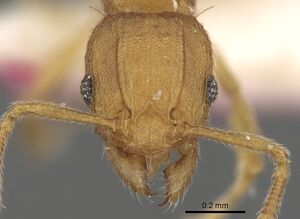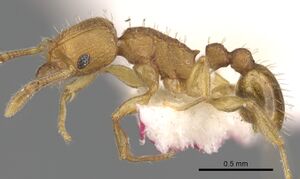Tetramorium rhetidum
| Tetramorium rhetidum | |
|---|---|

| |
| Scientific classification | |
| Kingdom: | Animalia |
| Phylum: | Arthropoda |
| Class: | Insecta |
| Order: | Hymenoptera |
| Family: | Formicidae |
| Subfamily: | Myrmicinae |
| Tribe: | Crematogastrini |
| Genus: | Tetramorium |
| Species: | T. rhetidum |
| Binomial name | |
| Tetramorium rhetidum Bolton, 1980 | |
A forest species with collection records that suggest it nests in the ground. A majority of the collections were from litter samples, and there is also a specimen that was found in the soil and another taken from under a log.
Identification
A member of the Tetramorium simillimum species group.
One of the four species of the simillimum-complex of this group in which the head has strong punctulate or granulate ground-sculpture, rhetidum is related to Tetramorium simillimum, Tetramorium bothae and Tetramorium delagoense. The last-named species is quickly differentiated as the sides of the head immediately behind the eyes have a single stout, freely projecting blunt hair which is absent in the other three species. Tetramorium rhetidum is separable from both T.simillimum and T.bothae on the following characters.
Tetramorium rhetidum
- Hairs on first gastral tergite dense and elongate, the longest equal to or greater than the maximum width of the hind tibia.
- Sides of head behind eyes with a number of minute decumbent curved hairs visible in full-face view.
- Eye conspicuously ovate, drawn out anteriorly, distinctly much longer than high in profile.
Tetramorium simillimum and Tetramorium bothae
- Hairs on first gastral tergite sparse and short, the longest distinctly shorter than the maximum width of the hind tibia.
- Sides of head behind eyes without such minute decumbent hairs.
- Eye more rounded, slightly longer than high in profile and more narrowly rounded in front than behind but not ovate or drawn out anteriorly.
Apart from these features the sculpture of T.rhetidum is coarser and more sharply defined than in its close relatives and the colour is more obviously brighter yellow than in T.simillimum. As indicated in the material examined T.rhetidum is apparently widely distributed in the rain forest zones of west and central Africa. This material compares well with the type-series and the measurements fall within the range given above.
Keys including this Species
Distribution
Latitudinal Distribution Pattern
Latitudinal Range: 6.417222222° to -24.96027°.
| North Temperate |
North Subtropical |
Tropical | South Subtropical |
South Temperate |
- Source: AntMaps
Distribution based on Regional Taxon Lists
Afrotropical Region: Cameroun, Democratic Republic of Congo, Gabon, Ghana (type locality), Ivory Coast, South Africa, United Republic of Tanzania.
Distribution based on AntMaps
Distribution based on AntWeb specimens
Check data from AntWeb
Countries Occupied
| Number of countries occupied by this species based on AntWiki Regional Taxon Lists. In general, fewer countries occupied indicates a narrower range, while more countries indicates a more widespread species. |

|
Estimated Abundance
| Relative abundance based on number of AntMaps records per species (this species within the purple bar). Fewer records (to the left) indicates a less abundant/encountered species while more records (to the right) indicates more abundant/encountered species. |

|
Biology
Castes
Worker
Images from AntWeb
   
| |
| Holotype of Tetramorium rhetidum. Worker. Specimen code casent0280867. Photographer Shannon Hartman, uploaded by California Academy of Sciences. | Owned by NHMUK, London, UK. |
Nomenclature
The following information is derived from Barry Bolton's Online Catalogue of the Ants of the World.
- rhetidum. Tetramorium rhetidum Bolton, 1980: 318, fig. 99 (w.q.) GHANA.
Unless otherwise noted the text for the remainder of this section is reported from the publication that includes the original description.
Description
Worker
TL 2.0, HL 0.50, HW 0.45, CI 90, SL 0.38, SI 84, PW 0.32, AL 0.61. Paratypes (8 measured): TL 1.9-2.1, HL 0.46-0.52, HW 0.43-0.46, CI 87-92, SL 0.36-0.40, SI 82-87, PW 0.30-0.34, AL 0.56-0.64. Maximum diameter of eye 0.11-0.12, about 0.25-0.27 x HW. Maximum separation of frontal carinae at eye level 0.24-0.26, about 0.55-0.58 x HW.
Mandibles glossy with superficial punctulation or faint shagreening, not longitudinally striate. Anterior clypeal margin arcuate and entire, without trace of a median notch or impression and with the median carina strongly defined. Frontal carinae strongly developed and very conspicuous, running back almost to the occipital margin and surmounted throughout their length by a low raised rim or crest, the carinae obviously more strongly developed than any other cephalic sculpture. Maximum separation of frontal carinae at eye level 0.26, about 0.58 x HW. Antennal scrobes broad and well developed, occupying the entire side of the head between the frontal carina and the eye and extending back almost to the occipital corner on each side. Eye markedly ovate, the anterior portion drawn out into a narrowly rounded point; maximum diameter of eye 0.12, about 0.26 x HW and with 7 ommatidia in the longest row. Propodeum armed with a pair of short triangular teeth which are slightly shorter and distinctly narrower than the metapleural lobes. Petiole node in dorsal view about as long as broad. Dorsum of head with a number of scattered, irregular but quite sharply developed longitudinal rugulae and with a weak reticulum on the occipital surface but this sculpture distinctly secondary to a very dense, blanketing reticulate-punctulation which is coarse and sharply defined. This punctulation also covering the scrobal areas where rugular sculpture is completely absent. Dorsal surfaces and sides of alitrunk and pedicel segments also coarsely and densely reticulate-punctulate, the alitrunk at least also with scattered fine rugulae. First gastral tergite unsculptured. All dorsal surfaces of head and body with numerous short stout blunt hairs which are more or less straight. With the head in full-face view the sides behind the eyes with a number of very short, curved decumbent hairs. Middle and hind tibiae only with minute pubescence which is decumbent or appressed. Colour uniform yellow, bright.
Type Material
Holotype worker, Ghana: Tafo, 2.ix.1970, litter sample (B. Bolton) (The Natural History Museum). Paratypes. 4 workers and | female with same data as holotype; 4 workers and | female with same locality but 25.xi.1970, log mould sample (B. Bolton) (BMNH; Museum of Comparative Zoology; Naturhistorisches Museum, Basel).
References
References based on Global Ant Biodiversity Informatics
- Belshaw R., and B. Bolton. 1994. A survey of the leaf litter ant fauna in Ghana, West Africa (Hymenoptera: Formicidae). Journal of Hymenoptera Research 3: 5-16.
- Belshaw R., and B. Bolton. 1994. A survey of the leaf litter ant fauna in Ghana, West Africa (Hymenoptera: Formicidae). Journal of Hymenoptera Research. 3: 5-16.
- Bolton B. 1980. The ant tribe Tetramoriini (Hymenoptera: Formicidae). The genus Tetramorium Mayr in the Ethiopian zoogeographical region. Bulletin of the British Museum (Natural History). Entomology 40: 193-384.
- Kouakou L. M. M., K. Yeo, K. Ouattara, W. Dekoninck, T. Delsinne, and S. Konate. 2018. Investigating urban ant community (Hymenoptera: Formicidae) in port cities and in major towns along the border in Côte d’Ivoire: a rapid assessment to detect potential introduced invasive ant species. Journal of Animal and Plant Sciences 36(1): 5793-5811.
- Kouakou L. M. M., W. Dekoninck, M. Kone, T. Delsinne, K. Yeo, K. Ouattara, and S. Konate. 2018. Diversity and distribution of introduced and potentially invasive ant species from the three main ecoregions of Côte d’Ivoire (West Africa). Belgian Journal of Zoology 148 (1): 83–103.
- Yeo K., and A. Hormenyo. 2007. A Rapid Survey of Ants in Ajenjua Bepo and Mamang River Forest Reserves, Eastern Region of Ghana. Pp 27-29. In McCullough, J., P. Hoke, P. Naskrecki, and Y. Osei-Owusu (eds.). 2008. A Rapid Biological Assessment of the Ajenjua Bepo and Mamang River Forest Reserves, Ghana. RAP Bulletin of Biological Assessment 50. Conservation International, Arlington, VA, USA.

